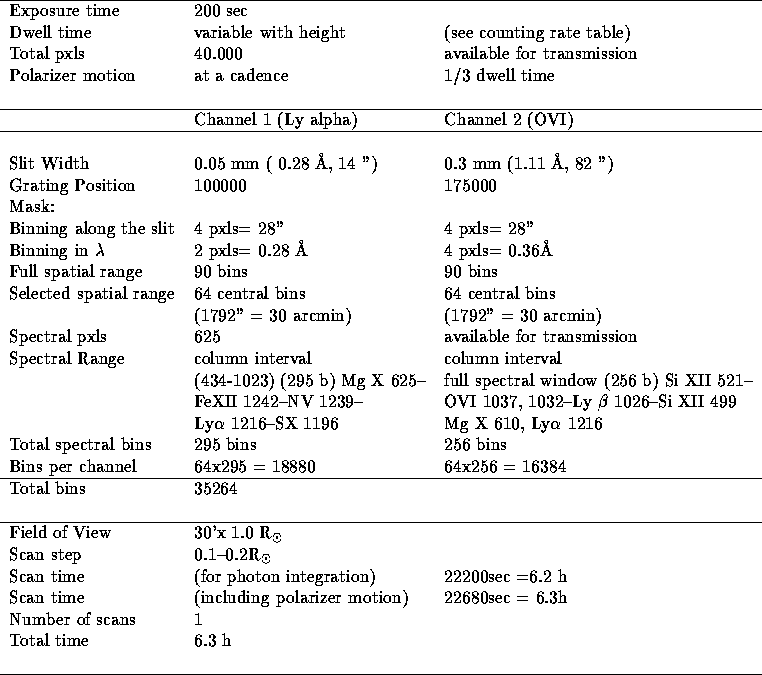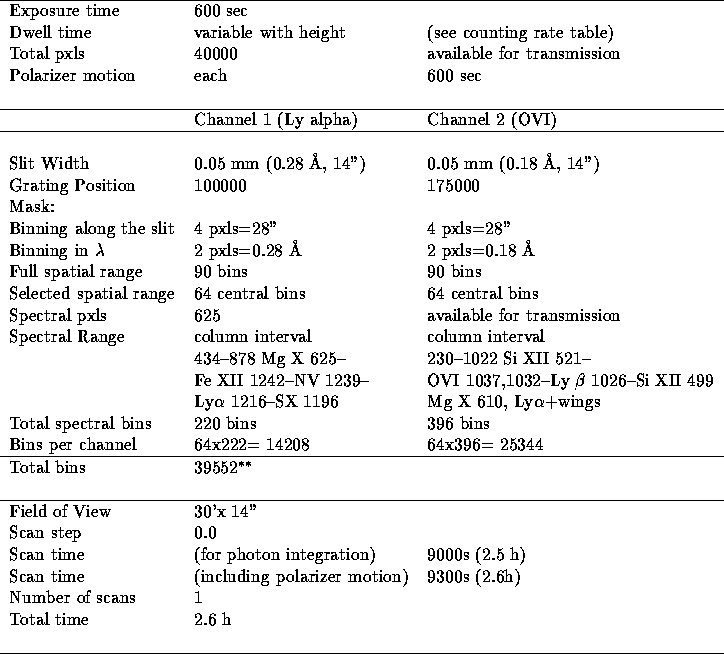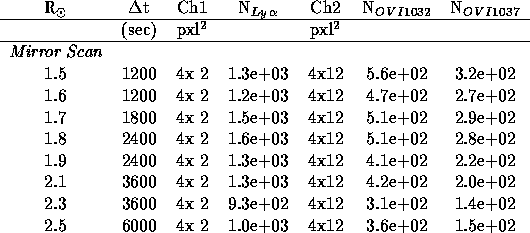
SOHO Joint Observing Plan 002
TEMPERATURE GRADIENT IN A CORONAL HOLE
A H Gabriel, F Bely-Dubau.
Participating scientists :
E. Antonucci, Turin
C David, IAS
J E Wiik, Obs Nice
Progress:

CDS ID: TGRAD
SUMER ID: 8.1.2.7 (Pop 34)
Objective: To determine the onset region of the solar wind by measuring
the vertical temperature gradient in a polar coronal hole.
Scientific Justification: Our knowledge of coronal temperatures in
open-field (coronal hole) regions is very limited. The intensity of
spectroscopic emission is very small, perhaps between 20 and 100 times less
than the closed field regions, due to the lower density by a factor of the
order 5 or more. SKYLAB observations have shown that ions typical of
temperatures around 1  K dominate, but clearly these temperatures are
limited by sensitivity to the first density scale height in the corona.
Important questions regarding the role of coronal holes in the
acceleration of the solar wind demande better information on the variation with
height of the coronal temperature.
K dominate, but clearly these temperatures are
limited by sensitivity to the first density scale height in the corona.
Important questions regarding the role of coronal holes in the
acceleration of the solar wind demande better information on the variation with
height of the coronal temperature.
Thermal models (eg Parker) of the solar wind acceleration require high
temperatures at the base of the wind. To explain the observed wind velocity we
need temperatures of the order 4  K. Such high temperatures are not
excluded by the present observations if the maximum occurs at heights not yet
observed in emission. However some recent models of the wind acceleration
propose direct transfer of momentum from Alfven waves to the medium, without
dissipation; that is without requiring high temperatures. In this case the 1
K. Such high temperatures are not
excluded by the present observations if the maximum occurs at heights not yet
observed in emission. However some recent models of the wind acceleration
propose direct transfer of momentum from Alfven waves to the medium, without
dissipation; that is without requiring high temperatures. In this case the 1
 K observed could be the maximum, and the temperature could fall
progressively at greater heights. Thus the determination of the temperature
gradient between 1' and 5' above the limb becomes a critical measurement.
K observed could be the maximum, and the temperature could fall
progressively at greater heights. Thus the determination of the temperature
gradient between 1' and 5' above the limb becomes a critical measurement.
Method: To measure the temperature, we depend upon a temperature-dependent
spectral line ratio. As the line-of sight is perpendicular to the principal
temperature gradient, we can propose to use a very sensitive line ratio, and
interpret the ratio in terms of a local isothermal plasma. We avoid using
ionisation ratios or differential emission measure analyses, since these
are based on the assumption of ionisation equilibrium, which might not be valid
in low density solar wind conditions. However, we include a set of Iron ion
lines for a DEM complementary analysis, which might give added information.
Since the region scanned (0 to 5 arcmin) could cover a range of temperatures,
we choose a lithium-like ion, which is generally present over a wide range.
The most sensitive ratio, taking account of solar abundance is that of oxygen
VI, 2s-2p / 2s-3d.
This ratio of lines at 1036 Å and 173 Å requires that one of the lines is
observed by the SUMER instrument and the other by the CDS. There will clearly
be some concern about the relative calibration at these two wavelengths, since
they arise from different instruments, with perhaps inprecise fields of view.
However we do not need absolute information for this ratio. It will be
sufficient to see how the temperature increases or decreases above the limb,
and to rely on the sun itself to provide the absolute temperature calibration
at the base.
Pointing and Target Selection: In view of the low emission of this part
of the corona, the only means to measure the temperature is by observations
tangentially at the limb. Coronal holes can exist at the poles of the sun,
particularly around solar minimum when SOHO will be launched. Holes will also
exist from time to time at lower latitudes. However, such low latitude holes
will in general have a much smaller extent in the line of sight. In view of
their low emissivity, their brightness will normally be contaminated by
non-hole regions in the line-of-sight in front of, and behind, the hole.
For reliable observations we are thus limited to the polar holes, which will
not suffer from this line-of-sight effect.
Since the SUMER and CDS slits are normally aligned N-S, it is necessary for
this measurement to rotate (roll) the spacecraft by 90 degrees, in order to
place the slits tangential to the limb at the poles. This manoevre has been
discussed and approved by the SWT, on the basis of a maximum period of 16 hours in the rolled position every 2 months.
Operating Details: Measurements of 1032 Å and 1038 Å lines with
SUMER present no problems as the lines are intense. For the 173 Å line from
CDS however there is a problem of intensity. If we choose the 8"  240" slit (provided for the NI channel) with the grazing incidence channel, and
align this parallel to the solar limb, then it is possible to propose a
sequence of 80 stepped positions starting just inside the limb with 25 s
exposures and finishing at 5 arcmins above the limb with 2500 s exposures. This sequence takes a total of 13 hours and gives 5% photon counting statistics per
position. It is however necessary to re-orient the roll position of SOHO by
90 degrees to achieve this measurement.
240" slit (provided for the NI channel) with the grazing incidence channel, and
align this parallel to the solar limb, then it is possible to propose a
sequence of 80 stepped positions starting just inside the limb with 25 s
exposures and finishing at 5 arcmins above the limb with 2500 s exposures. This sequence takes a total of 13 hours and gives 5% photon counting statistics per
position. It is however necessary to re-orient the roll position of SOHO by
90 degrees to achieve this measurement.
CDS Programme :
PHASE 1

PHASE 2

PHASE 3

Product: Scan of all GIS spectrum from 16 arcsec within limb to 304 arcsec above
limb, from a 240 arcsec wide swath.
SUMER Programme Item 1:
Interruption or flag mode: No interruption.
Slit 1 with 1*300 arcsec
.
Initial pointing:
= 0.00 arcsec
= 986.00 arcsec
SOHO roll angle: 90.0000 deg
Solar rotation: No compensation.
Binning (spectral) = 1
(spatial) = 1
Compression: 5. Quasilog_min_max (0.92 s)
Reference pixel 1: 500 on detector A
Flat-field correction: OFF
Ion(s) in band 1:
O VI .... 1031.91 Å
O VI .... 1037.61 Å
Spectral window(s) (pixel) 50
Image format: Format #8 (50*360, B1); 2 time(s)
Spectrohelio mode: Spectrohelio 1
Scan from South to North.
Integration time: 25.0000 s
Step size: 0.380000 arcsec or 1 units.
Step number: 52
Step mode: Normal steps
Repetition number: 1
Staggering: 1
Your selection requires
a telemetry rate: 11.5200 kbit/s
Bitrate: 10.0000 kbit/s
This item will run
for approximately: 22.3818 minutes
and will cover a solar area defined by
300 px time(s) 19.76 arcsec

Note that the memory monitoring and the run times are not very accurate. The run
times just give the total exposure times with a margin of 1%. More detailed information
can be provided by the SUMER Simulator.
All items up to now will run
for approximately 22.3818 minutes
SUMER Programme Item 2:
Interruption or flag mode: No interruption.
Slit 1 with 4*300 arcsec
.
Initial pointing:
= 0.00 arcsec
= 1148.00 arcsec
SOHO roll angle: 90.0000 deg
Solar rotation: No compensation.
Binning (spectral) = 1
(spatial) = 1
Compression: 5. Quasilog_min_max (0.92 s)
Reference pixel 1: 500 on detector A
Flat-field correction: OFF
Ion(s) in band 1:
O VI .... 1031.91 Å
O VI .... 1037.61 Å
Spectral window(s) (pixel) 50
Image format: Format #8 (50*360, B1); 2 time(s)
Spectrohelio mode: Spectrohelio 1
Scan from South to North.
Integration time (low): 25.1355 s
Integration time (high): 2903.23 s
Step size: 3.80000 arcsec or 10 units.
Step number: 80
Step mode: Normal steps
Repetition number: 1
Staggering: 1
Your selection requires
a telemetry rate from: 0.0991997 kbit/s
to: 11.4579 kbit/s
Bitrate: 10.0000 kbit/s
This item will run
for approximately: 840.971 minutes
and will cover a solar area defined by
300 px time(s) 304.000 arcsec

Note that the memory monitoring and the run times are not very accurate. The run
times just give the total exposure times with a margin of 1%. More detailed information
can be provided by the SUMER Simulator.
All items up to now will run
for approximately 863 353 minutes
EIT Programme:
Programme objectives :
(images required in all 4 channels)
UVCS Programme:
PURPOSE:
Measure velocity, density and temperature gradient above  1.5
R
1.5
R (at completion of UVCS calibration an initial
heliodistance of 1.4 R
(at completion of UVCS calibration an initial
heliodistance of 1.4 R might be chosen).
might be chosen).
 (sit and stare).
(sit and stare).
 - Visible light 4500 - 6000 Å (polarized)
(mirror scan).
- Visible light 4500 - 6000 Å (polarized)
(mirror scan).
 , to
map the kinetic temperature of protons, and
2 Sit and Stare observations for line profiles.
, to
map the kinetic temperature of protons, and
2 Sit and Stare observations for line profiles.a) MIRROR SCAN

b) SIT AND STARE

Observing Sequence JOP--2--CH :
Temperature in Coronal Holes
Mirror Scan

Sit and Stare

CORONAL HOLE
Mirror Scan
Predicted Counting Rate

Sit and Stare
N--Predicted Counting Rate

Note:
The counting rate can be multiplied by a factor of 8.6 which means an
integration along the slit comparable to the spatial resolution of CDS.
It can be multiplied by
an additional factor of 2 in the case of the Sit and Stare
observation being this observation repeated.
LASCO Programme
Objectives :
method: use planned synoptic programme, with the possibility of optimising the data rate from the polar region chosen.
MDI Programme:
To map the line-of sight magnetic field
Ground-based observations (optional):
Magnetic fields, 10830 Å and Ca K maps for coronal hole morphology.